3 cases of introducing dynamic content, which increased the return on contextual advertising by 3 times
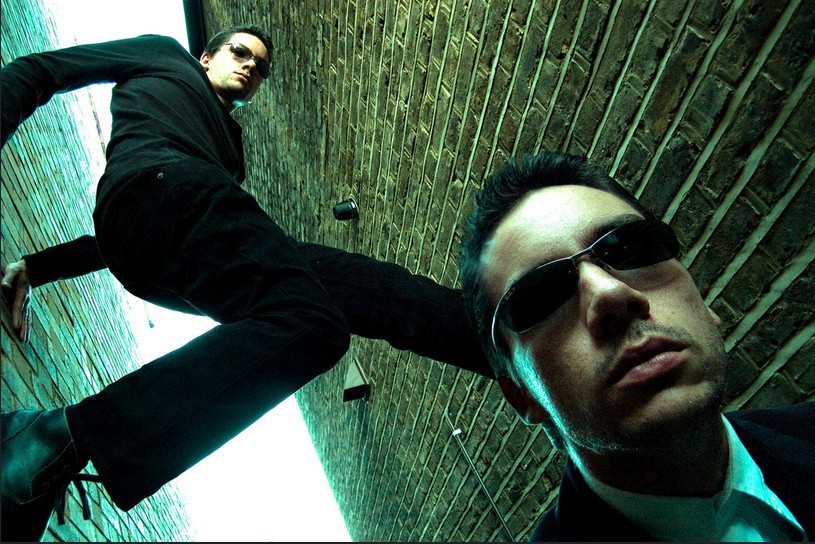
The life of a director is dangerous and difficult. It is not so easy to collect targeted traffic, conjure over lowering the cost of a click, fight for positions with competitors. We ourselves went through this until we were tired of fighting for the hundredths of a CTR.
In this article, we talk about how to get out of the competition with the help of dynamic content, and show the results of increasing conversion with specific examples.
About Competition
Compared to other promotion channels, contextual advertising has the largest budgets of the last five years and their sizes continue to increase. At the same time, the number of Internet users is growing much more slowly than cash injections.
For example, in 2014, the contextual advertising market grew by 30%, and the number of users grew by only 9% (data for Russia).
This means that the cost of attracting a client from contextual advertising is growing by leaps and bounds.

Businesses urgently need to increase the return on context or reduce the cost of leads. In order to maintain the current marginality, subject to five times more competition, the cost of leads should be 5 times less, without loss of quality.
We tried many options for increasing the return on contextual advertising and found a way that can increase the efficiency in some cases several times. Not 30-60%, but really 2-3-5 times depending on the source data - this is dynamic content.
The bottom line is to change the content of the landing page, depending on the user's search query. This is a combination of traffic hypersegmentation and offer personalization (trading offer).
How it works?
Typically, traffic from contextual advertising for a particular product or service leads to one landing page. At the same time, users have different reasons to buy the same product - just look at the search phrases for which they get to the site.
We decided to show different headings, subheadings, buttons to application forms and even pictures. So that users see information that is important for themselves right on the first screen (personalization of the offer). This is dynamic content.
At first glance, everything is simple: take search queries from the campaign, group, write unique offers for each group in substitutions (several options are desirable), conduct A / B testing, identify the most conversion options, sit and rejoice at lower lead costs.

In fact, not everything is so simple. We have automated a number of processes: synchronization with advertising campaigns through the API, automatic selection of the winning option, collecting and tracking statistics, and setting up the substitution itself in a convenient table form. But more on that later. In the beginning, how and why it works.
Case of a window company
This is a regional company manufacturing and installing plastic windows. Contextual advertising - the main channel, works to load production. The competition is very tough: they copy from each other the location of the blocks, the structure of the pages and even the design.
The cost of a click on key requests (“plastic windows calculator”, “buy PVC windows”) in Moscow, for example, reaches 84 cu Just imagine: 2,520 rubles per click! In the regions, the figures are, of course, more modest (100-150 rubles), but still this is a lot.
If we take into account the average conversion of the landing in this niche of 4-5%, one application costs 2,000 - 3,000 rubles. And that’s not all) An application is not equal to a sale. Suppose every third lead sets a window. Thus, the final cost of the client is 6,000 - 8,000 rubles.
What was done:All requests from the campaign in Yandex.Direct were divided into large groups, because they decided to move away from maximum relevance. This principle works great when setting up contextual advertising when a request = an ad headline plus a request is present in the text of the ad itself. In the case of content on the site, this is not enough.
Based on the search query, we built a portrait of the user. Out of 234 phrases, 28 groups made, for each group unique trading offers were written. Next, it was necessary to check how accurate the models we built. Therefore, we set goals, launched traffic and conducted A / B testing for each group (comparison of substitution with the original).
Two weeks later, the first results were obtained: conversion increased by 1.5 times. They simply divided requests for groups, wrote other offers for them, and from the first “shot” they increased the conversion by one and a half times!
Here's how it works in the system:

It's simple: you look at the status of the A / B tests: the hourglass icon means that there is not enough traffic, testing continues. Green checkmark - the changeover conversion is higher than the original version; “Red brick” - rewrite and put in a second test.
We did just 4 iterations this way. This is not much to positively influence business performance. The test time is 1.5 months. The result is a 3.3-fold increase in conversion, while the quality of the leads remains the same. And this is without additional costs for contextual advertising. For verification, we repeated this result many times in different businesses.
Case SEO Agency
A similar problem with the high cost of lead, as professional promoters compete for the same traffic.
You can collect a ton of near-targeted traffic, but it is hard to convert to leads. These are such requests as: “advertising on billboards”, “advertising on TV”, “advertising on radio”, “advertising on transport”. Because the company is engaged in SEO.
We set a task to transfer traffic on these requests to our channel. Potential customers are people who are going to spend advertising budgets and choose a promotion channel. And at the request of "advertising on TV" a person gets on the site, and there the heading "SEO vs Advertising on TV". And the three main benefits.
Plus they took such requests: “how to promote business X” (for example, “how to promote a beauty salon” or “promote a site of legal services.” Or general business requests “how to increase sales.” Accordingly, they made headings for them:
Option 1
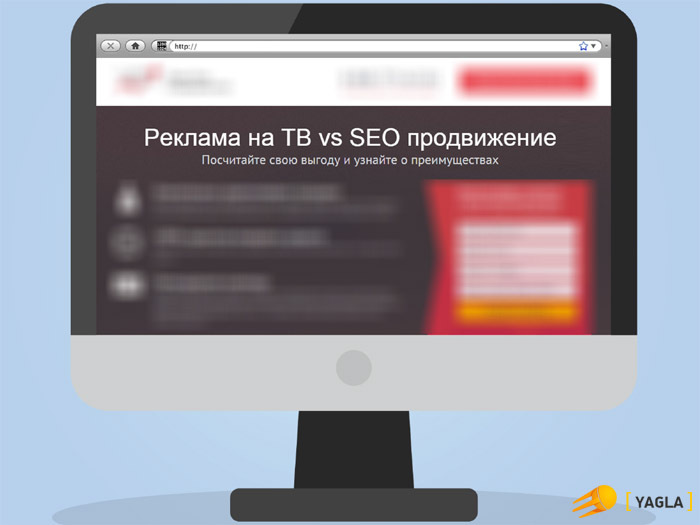
Option 2
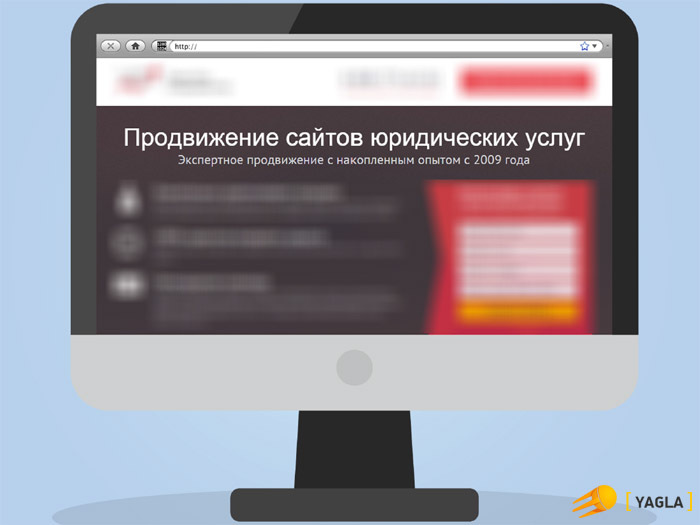
Total The project received 472 groups. a month later received an increase in website performance by 2.5 times, from 3.5% to 8.7% conversion application.
Case wholesale deliveries
The company is engaged in the wholesale supply of thousands of goods from China, almost any item. This is not an online store, you can not put goods in a basket. The user leaves a request for a price on the site.
The landing page was originally designed as universal. In the first screen, you could replace anything you like, and the rest of the screens fit almost any product, as there was information about delivery, payment methods, trust triggers, etc.
A total of 10,859 product queries, of which 1,425 groups were obtained. The heading was once compiled using the 4U method, but the rest was tuned to the principle of direct relevance. The user is looking for a specific product, the title is equal to the name of this product. Also a signature to the application form: for example, “get a price for monopods”.
Результат – увеличение конверсии в 3,6 раза, с 4,8% до 17,5%. Феноменальный показатель для оптовой компании!
ТОП-5 Кому это подходит
Это ситуации, когда динамический контент работает лучше всего.
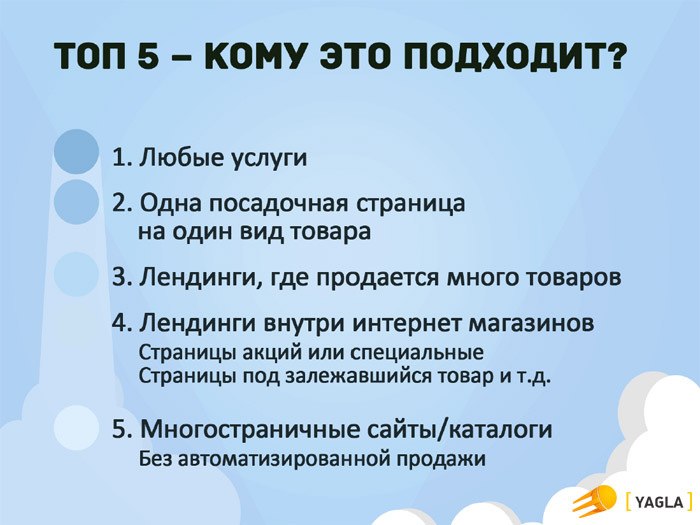
1) Лендинги с услугами. У них, как правило, очень небольшой пул ключевых фраз и включение в кампанию околоцелевых запросов дает значительный рост конверсии.
2) Лендинг под один вид товара. Например, айфоны или пылесосы одного бренда. Здесь можно отлично отработать офферы по конкурентам, методам использования.
3) Лендинги под группу типовых товаров.For example, ten woodworking machines. The user knows the problem, but does not yet know how to solve it. And here, using dynamic content, we offer him a specific tool, which is displayed in the header.
4) Product landing pages inside online stores. Emphasis on a stock, seasonal discounts or product balances. Of course, here you need to think, work on setting up offers, since there are much more requests (a campaign for 10,000 phrases is considered normal for an online store).
5) Multipage sites. Why are they only in fifth place? Scanty description of the goods: here it is effective to replace only the title and text of the target action on the CTA button.
Why does it work?
There are many studies that say that the user decides in 5-7 seconds whether he will stay on this page or leave. When all competitors have an offer without personalization, that is, it is designed for everyone, and in your case it falls into the pain or need of a specific user, here you are the winner. The visitor should have an insight: “Oh, I found what I need!” That's when it works fine.
Which content is best done responsive?
We recommend first of all headings and subheadings, then signatures to lead forms and CTA buttons (calls to action), and lastly images.
The most effective way is to replace the elements of the first screen due to the five-second rule. On the whole landing we recommend replacing no more than 5-6 elements. This is enough to maximize conversion.
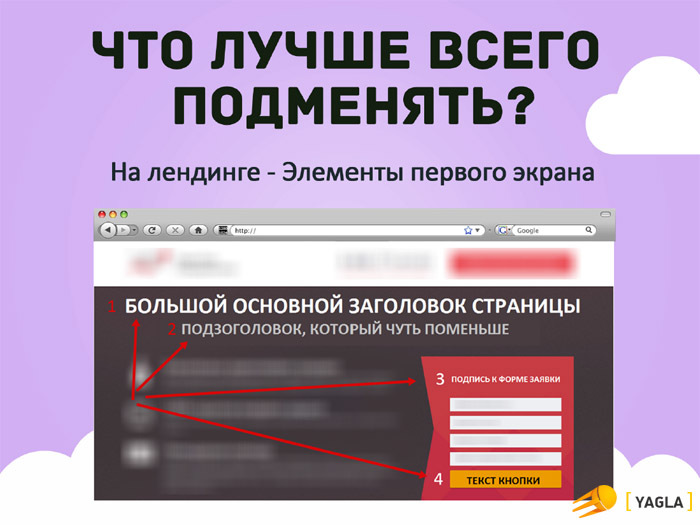
As a second example, the landing page of an online store, where the CTA button is actually a subtitle, is one of the most noticeable elements. Yes, this is the same page where the button is substituted for requests from contextual advertising.
Initial option:

Substitution No. 1

Substitution No. 2

We recommend that you make headings using the 4U method . There is a lot of information about them on the Internet, we have material in our blog .
Such headings include utility, uniqueness, ultra-specificity and urgency. They, as a rule, are long and ugly, but in combination with hypersegmentation perfectly increase the return. With the correct setting - 2-3 times.

Fatal errors of multi-linguals
Adaptive content tuning is mainly done by contextual advertising specialists. They step on the same rake because they are used to Yandex.Direct mechanics. We mark the TOP 4 most common errors of adaptive content ( see the sensational material on the CPU for the full version ).
So, in the first place, the situation is “Request = Header”. Logic Direct, when the ad title = user request, in our case does not work. More precisely, it does not show any significant increase in conversion or even reduces it.
We call this a “big relevant spot” when there is a task to stand out from a list (search results). But when you go to the site (landing page), you need to get into the user's need. Not “book a table in St. Petersburg”, but “Book a table in the best restaurant in St. Petersburg in 5 minutes without deposit”. Feel the difference?
We analyzed 342 projects, in 326 cases, due to this error, the conversion either fell or remained at the initial level.
The following situation - the goals are not configured and there are no A / B tests. This means that you do not have statistics on goals, therefore, it is impossible to understand the effectiveness of substitutions. Most often, when setting up volumetric dynamic content, users of our system missed. To obtain the result, several iterations (steps) are needed, and without A / B tests this is impossible. How to identify elements that have worked worse?
In third place was “unadaptation”, when on the first screen the content was changed, and on the rest of the landing it remained under the original version. When scrolling, the user sees a discrepancy, distrust arises, a feeling of deception, and he leaves.
And No. 4 is the substitution of minor elements that do not affect the conversion (for example, the signature on the button from “Order a call back” to “Call me back.” This is useless work.

How can responsive content be implemented?
At first we used the “handmade”. This is a special script, available tools in the form of GTM tags, Google Tag Manager with their counter. The problem was not even that programming knowledge was needed, but that it was hard to implement and manage the results. In addition, I had to recalculate the statistics manually. Ideal for testing if there are no others.

You can go further and use one of the A / B testing systems. We used Optimizely. Programming knowledge is no longer needed, but a whole lot of time is spent setting up for query groups. Moreover, if an advertising campaign in Yandex.Direct has already been set up, it needs to be redone in a specific way. This means that you need to set up your account so that each group of requests is in a separate campaign. Yes, and this process is difficult to manage, control statistics.

Therefore, we made our own development - the Yagla responsive content service. In one click we synchronize Jagla and the advertising campaign in Yandex.Direct via the API, mark the elements that we want to make replaceable. There is a visual editor for this, regardless of the CMS site. We put two lines of code on the site, it is as simple as setting a traffic counter. And in the form of a table, we configure all the content.
The directors know that this is most conveniently done in the form of a table: queries on the right, announcements on the left. We have requests on the right, content for substitutions on the left.

And finally, a series of automatic A / B tests. They pass under each group of requests (comparison of substitution with the original), statistics are collected in one place. What we did in Optimizely in 4 hours, in Yagl - in 7 minutes.
Instead of a conclusion
Like any technological startup, we develop in motion: we collect feedback from customers, fix bugs, and “finish” new functionality. Yes, in July we plan to launch the customization of adaptive content in Google Adwords, a test version is already ready. In a word, let's go forward.
Ask your questions about the service in the comments. Your feedback is very important to us.
Head of Yagla.ru Alexander Alimov
